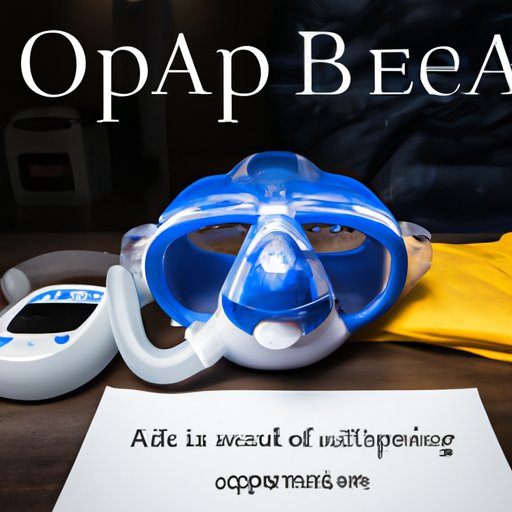Introduction
Sleep apnea is a chronic sleep disorder that occurs when a person’s breathing is repeatedly interrupted during sleep. It can lead to daytime sleepiness, snoring, difficulty concentrating, and other health problems. A sleep apnea machine is a device used to treat sleep apnea by providing continuous positive airway pressure (CPAP) or auto-adjusting positive airway pressure (APAP) therapy. In this article, we will explore how a sleep apnea machine works, the benefits of using one, potential risks, costs involved and insurance coverage.

Explaining the Different Components of a Sleep Apnea Machine
A sleep apnea machine is composed of several parts: a mask, tubing, humidifier, and motor. The mask is worn over the nose and/or mouth while the patient sleeps, and the tubing connects the mask to the motor. The motor controls the flow of air, which is then delivered through the tubing to the mask. The humidifier adds moisture to the air, which makes it more comfortable for the patient to breathe. There are two types of sleep apnea machines: CPAP and APAP.

Describing the Types of Machines
Continuous positive airway pressure (CPAP) machines deliver a steady stream of air at a consistent pressure throughout the night. Auto-adjusting positive airway pressure (APAP) machines monitor the patient’s breathing and adjust the pressure accordingly. Both types of machines help keep the airways open, allowing the patient to breathe more easily.

Discussing the Parts of a Sleep Apnea Machine
The mask is the most important part of the sleep apnea machine. It fits tightly over the nose and/or mouth and is held in place by straps. The tubing connects the mask to the motor and delivers the air to the patient. The humidifier adds moisture to the air, making it easier to breathe. The motor controls the flow of air and provides the necessary pressure to keep the airways open.

Describing the Benefits of Using a Sleep Apnea Machine
Using a sleep apnea machine can have many benefits, including improved quality of sleep, reduced risk of heart disease and stroke, enhanced cognitive function, and improved overall health. These machines can also reduce snoring and help people feel more rested during the day.
Examining the Potential Risks of Using a Sleep Apnea Machine
Although a sleep apnea machine can be beneficial, there are some potential risks associated with its use. Skin irritation, nasal congestion, and dry mouth are some of the most common side effects. Additionally, some people find the noise of the motor to be disruptive.
Exploring the Impact of a Sleep Apnea Machine on Quality of Sleep
Using a sleep apnea machine can significantly improve the quality of sleep. Patients experience less disruption from their sleep apnea and are able to get a more restful night’s sleep. Additionally, the increased comfort level provided by the mask and humidifier can make sleeping easier. Finally, the reduction in snoring can provide relief for both the patient and their partner.
Discussing the Cost of a Sleep Apnea Machine and Insurance Coverage
Sleep apnea machines can be expensive, ranging from $500 to $3000 depending on the type and features. Insurance companies may cover some or all of the cost of a sleep apnea machine, but it is important to check with your insurer before making a purchase. Some insurers require a prescription from a doctor before they will cover the cost.
Conclusion
Sleep apnea machines are an effective treatment for sleep apnea, providing continuous positive airway pressure (CPAP) or auto-adjusting positive airway pressure (APAP) therapy. They can help improve the quality of sleep, reduce snoring, and reduce the risk of heart disease and stroke. While there are potential risks associated with their use, such as skin irritation and nasal congestion, these can be minimized with proper use. The cost of a sleep apnea machine can vary widely, but many insurance companies provide coverage for part or all of the cost.
(Note: Is this article not meeting your expectations? Do you have knowledge or insights to share? Unlock new opportunities and expand your reach by joining our authors team. Click Registration to join us and share your expertise with our readers.)
